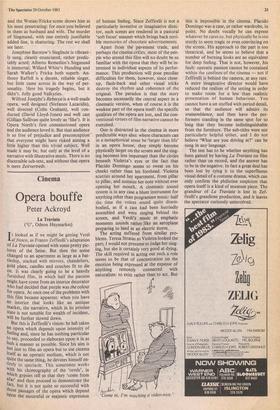Cinema
Opera bouffe
Peter Ackroyd
La Traviata ('U', Odeon Haymarket)
I t looked as if we might be getting Verdi la/fresco, as Franco Zeffirelli's adaptation of La Traviata opened with some pretty pic- tures of the Seine. But then the scene changed to an apartment as large as a bat- tleship, stacked with mirrors, chandeliers, gold plate, candles and couches fit to die on. It was clearly going to be a heavily furnished film, in which half the passion might have come from an interior decorator Who had decided that purple was the colour for opera. At once one of the problems with this film became apparent: when you have an interior that looks like an antique Market, the narrative, which in its pristine state is not notable for wealth of incident, Will be further slowed down.
But this is Zeffirelli's vision: he hat taken an opera which depends upon intensity of feeling and, since he has nothing particular to say, proceeded to elaborate upon it in as lush a manner as possible. Since his aim is not just to film an opera but to use cinema itself as an operatic medium, which is not quite the same thing, he devotes himself en- tirely to spectacle. This sometimes works With his choreography of the 'revels', in Which gypsies tell us that they 'come from afar' and then proceed to demonstrate the fact, but it is not quite so successful with those passages of the opera which depend Upon the mournful or majestic expression
of human feeling. Since Zeffirelli is not a particularly inventive or imaginative direc- tor, such scenes are rendered in a pastoral 'soft focus' manner which brings back terri- ble memories of chocolate advertisements.
Apart from the pavement trade, and perhaps the cinema critics, most of the peo- ple who attend this film will no doubt be so familiar with the opera that they will be in- terested in individual aspects of its perfor- mance. This production will pose peculiar difficulties for them, however, since close- up, flash-back and other visual tricks destroy the rhythm and coherence of the original. The paradox is that the story becomes necessarily the central aspect in a cinematic version, when of course it is the weakest part of the opera itself: the specific qualities of the opera are lost, and the con- ventional virtues of film narrative cannot be exercised.
One is distracted in the cinema in more predictable ways also: where characters can in a metaphorical sense be 'larger than life' in an opera house, they simply become physically larger on the screen and the sing- ing becomes less important than the circles beneath Violetta's eyes or the fact that Placido Domingo seems to sweat on his cheeks rather than his forehead. Violetta scurries around her apartment, from pillar to pillar, and sustains her note without ever opening her mouth. A cinematic sound system is in any case a blunt instrument for anything other than programme music: half the time the voices sound quite disem- bodied, as if a cast had been hurriedly assembled and were singing behind the screen, and Verdi's music at emphatic moments sounds, rather Pike an aeroplane preparing to land in an electric storm.
The acting suffered from similar pro- blems. Teresa Stratas as Violetta looked the part; I would not presume to judge her sing- ing, but she is certainly very good at dying. The skill required in acting out such a role seems to be that of concentration on the emotion being expressed at the expense of anything remotely connected with naturalism: to exist rather than to act. But 'Come in, I'm watching a video-nice.'
this is impossible in the cinema. Placid° Domingo was a case, or rather wardrobe, in point. No doubt vocally he can express whatever he cares to, but physically he is too sturdy to seem tragic or even convincing on the screen. His approach to the part is too theatrical, and he seems to believe that a number of burning looks are an equivalent for deep feeling. That is not, however, his fault: operatic passion cannot be contained within the confines of the cinema — not if Zeffirelli is behind the camera, at any rate. A more imaginative director would have reduced the realism of the setting in order to make room for a less than realistic presentation of human behaviour. You cannot have a set stuffed with period detail, so that the audience will admire its vraisemblance, and then have the per- formers standing in the same spot for so long that they become indistinguishable from the furniture. The sub-titles were not particularly helpful either, and I do not believe 'What are you driving at?' can be sung in any language.
The test has to be whether anything has been gained by having La Traviata on film rather than on record, and the answer has to be in the negative. In fact a great deal has been lost by tying it to the superfluous visual detail of a costume drama, which can only confirm the philistine suspicion that opera itself is a kind of museum piece. The grandeur of La Traviata is lost in Zef- firelli's grandiose production, and it leaves the spectator curiously uninvolved.














































 Previous page
Previous page